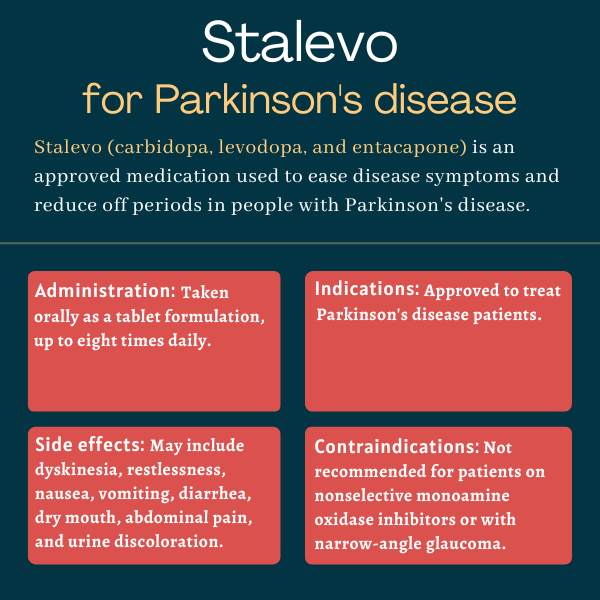Stalevo (carbidopa, levodopa, and entacapone) for Parkinson’s disease
What is Stalevo for Parkinson’s disease?
Stalevo is an approved oral therapy containing a combination of three medications, carbidopa, levodopa, and entacapone, that is used to ease symptoms of Parkinson’s disease.
The therapy also can reduce off episodes, or periods when a medication wears off and motor symptoms return, in patients who are experiencing those fluctuations while on treatment with a combination of levodopa and carbidopa. It also can be prescribed to patients who are taking carbidopa/levodopa therapy and entacapone as separate medications.
The oral medication was originally developed by Orion Pharma and is distributed in the U.S. by Almatica Pharma. A number of generic equivalents for Stalevo also are available.
Therapy Snapshot
| Brand Name: | Stalevo |
| Chemical Name: | Carbidopa, levodopa, and entacapone |
| Usage: | Used to ease symptoms of Parkinson’s disease; can reduce off episodes |
| Administration: | Oral tablets |
How does Stalevo work?
Parkinson’s disease is caused by the progressive loss of specialized nerve cells in the brain that produce the neurotransmitter dopamine. A chemical messenger, dopamine enables nerve cells to communicate with each other and with various muscles in the body.
Dopamine can not be directly administered to patients because it cannot cross the blood-brain barrier, a highly selective membrane that protects the brain and spinal cord from circulating toxins and bacteria, and is often an obstacle for therapies that need to reach nerve cells in the brain.
Given that, people with Parkinson’s are commonly treated with a combination of levodopa and carbidopa. Levodopa is a precursor of dopamine that can cross the blood-brain barrier and be converted into dopamine in the brain, helping to increase levels of this neurotransmitter in people with Parkinson’s.
However, when levodopa is administered orally, it is rapidly broken down by a biological process called decarboxylation, which limits the amount that reaches the brain. Carbidopa is used inhibit this process, enabling more levodopa to enter the brain and be converted to dopamine.
While this combination can effectively manage the motor symptoms of Parkinson’s, there is another process that also breaks down levodopa before it reaches the brain. This process, called methylation, can be prevented by entacapone, a selective inhibitor of the methylating enzyme called catechol-O-methyltransferase (COMT inhibitor).
When entacapone is given in conjunction with levodopa and carbidopa, levels of levodopa in the blood are found to be greater and more sustained than after the administration of levodopa and carbidopa alone. Thus, the medications together are expected to provide better control of motor symptoms.
Who can take Stalevo?
Stalevo was approved by the U.S. Food and Drug Administration in 2003 to treat people with Parkinson’s disease. The approval included two indications:
- One is the use of Stalevo as a substitute therapy for patients receiving levodopa/carbidopa plus entacapone as separate medications, with equivalent strengths of each of the three components.
- The other is the administration of Stalevo as a replacement for carbidopa/levodopa therapy alone in patients experiencing off-periods toward the end of the timeframe between doses. Patients must be taking 600 mg or less of levodopa before switching, and also must not be experiencing dyskinesia, or uncontrolled, involuntary movements.
The treatment gained approval in the European Union in 2003, where it can be used for similar indications as in the U.S. It’s also approved in Australia, Canada, Japan, and Turkey for the treatment of Parkinson’s disease.
Who should not take Stalevo?
Stalevo is not recommended for people who are undergoing treatment with a nonselective monoamine oxidase (MAO) inhibitor — an antidepressant medication — or who have received an MAO inhibitor within the prior two weeks. The combination of these medications can result in elevated blood pressure.
The medication also should not be administered to individuals with narrow-angle glaucoma, a disease that can cause vision loss and blindness.
How is Stalevo administered in Parkinson’s?
Stalevo is available as film-coated tablets that are administered orally. These come in six strengths, each containing different doses of levodopa and carbidopa and a fixed dose of entacapone:
- Stalevo 50 contains 50 mg of levodopa, 12.5 mg of carbidopa, and 200 mg of entacapone. These round tablets are brownish- or grayish-red and have “LCE 50” embossed on one side.
- Stalevo 75 is comprised of 75 mg of levodopa, 18.75 mg of carbidopa, and 200 mg of entacapone. Oval-shaped tablets, they are light brownish red with “LCE 75” embossed on one side.
- Stalevo 100 contains 100 mg of levodopa, 25 mg of carbidopa, and 200 mg of entacapone. These oval-shaped tablets are brownish- or grayish-red and have “LCE 100” embossed on one side.
- Stalevo 125 is comprised of 125 mg of levodopa, 31.25 mg of carbidopa, and 200 mg of entacapone. Oval in shape, these tablets are light brownish red with “LCE 125” embossed on one side.
- Stalevo 150 consists of 150 mg of levodopa, 37.5 mg of carbidopa, and 200 mg of entacapone. These elongated-ellipse shaped tablets are brownish- or grayish-red and have “LCE 150” embossed on one side.
- Stalevo 200 contains 200 mg of levodopa, 50 mg of carbidopa, and 200 mg of entacapone. These are oval shaped tablets and dark brownish red, with “LCE 200” embossed on one side.
The appropriate daily dosage should be determined through cautious titration for each person. Titration is a technique used to find the optimum dose of a drug needed to produce the desired effect for an individual patient.
The maximum recommended daily dosage of Stalevo varies depending on the strength of the medication. For Stalevo 50 to 150 tablets, patients can take a maximum of eight tablets per day; those on Stalevo 200 tablets can receive a maximum of six daily tablets. In both cases, daily doses of levodopa go up to a maximum 1,200 mg daily, but maximum recommended doses of entacapone vary.
Stalevo can be used as a replacement for patients who are already receiving non-extended release carbidopa/levodopa and entacapone. Thus, if a patient is already receiving 200 mg entacapone with a carbidopa/levodopa tablet, the patient can switch to a strength of Stalevo that contains the same amounts of levodopa and carbidopa.
There are no reported data on transitioning patients from an extended-release formulation of levodopa and carbidopa, or from products containing different ratios of levodopa and carbidopa, to Stalevo.
In other cases, Stalevo may be considered for patients receiving a stable dose of carbidopa and levodopa, but for whom the decision has been made to include entacapone in their treatment.
In such cases, individuals with a history of moderate or severe dyskinesia or those taking more than 600 mg of levodopa daily will likely need to decrease their daily levodopa dosage when entacapone is introduced.
However, because all strengths of Stalevo contain 200 mg of entacapone, combining multiple tablets to achieve a higher levodopa dose may result in an overdose of entacapone. Therefore, dose adjustments should be conducted with separate levodopa/carbidopa and entacapone tablets before switching patients to the equivalent dose of Stalevo.
Tablets should not be split, crushed, or chewed, and should be administered as a whole unit at the prescribed dose. Stalevo can be taken with or without food, but patients should be aware that consuming a high-fat, high-calorie meal may cause a delay in the absorption of levodopa by approximately two hours.

Stalevo in clinical trials
The efficacy of entacapone as an addition to levodopa treatment for Parkinson’s disease was established through three placebo-controlled studies. Two studies focused on patients who were experiencing off periods, or motor fluctuations, despite optimal levodopa therapy. The third trial did not require patients to have motor fluctuations.
Trials in patients with off periods
In the first two studies, participants were randomly assigned to receive either a placebo or 200 mg of entacapone alongside each of their carbidopa/levodopa doses, up to a maximum of 10 times per day. Throughout the trial, patients kept track of the time they spent in on and off states by recording it in home diaries.
In one of these studies, 171 patients received concurrent treatment with levodopa and a DOPA decarboxylase inhibitor, specifically either carbidopa/levodopa or benserazide/levodopa. The trial’s main goal was the average total time spent in the on state (with adequate control of motor symptoms) throughout an 18-hour day, as recorded in patient diaries throughout six months.
When compared with those on the placebo, patients who received entacapone reported a statistically significant increase of awake time in the on state, by an average of 1.5 hours, while also experiencing less overall time (by an average of 1.3 hours) in the off state. They also reported taking less levodopa during the day.
Patients on entacapone also experienced significantly greater improvements in their motor skills and in their ability to perform activities of daily living, as measured with the second and third parts of the the Unified Parkinson’s Disease Rating Scale (UPDRS).
In the other study, 205 patients received concurrent treatment with carbidopa/levodopa. The trial’s main goal was the proportion of daily time spent in the on state, throughout a time period of six months.
Patients who received entacapone, in comparison to those who received a placebo, reported a statistically significant increase in the proportion of time spent awake in the on state — by about one hour. Additionally, they experienced a significant reduction in off time, by an average of 1.2 hours.
Results showed that these patients also reported a decrease in levodopa intake throughout the day and demonstrated improved motor outcomes and a greater ability to perform daily activities.
Trial in patients regardless of off periods
In a third study, 301 patients — 260 of whom had clinically significant motor fluctuations — received either a placebo or 200 mg of entacapone with each dose of levodopa and dopa decarboxylase inhibitor. The trial’s main goal was to evaluate improvements in motor function and activities of daily living, as well as total daily on time after six months of treatment. Gains in motor function and daily living activities were assessed by the UPDRS Parts II and III.
When compared with those who received a placebo, patients on entacapone had statistically significant improvements in both motor function and activities of daily living. They also reported, on average, 1.1 more hours of awake time in the on state and 1.2 less hours awake in the off state.
FIRST-STEP study
The FIRST-STEP Phase 3 study (NCT00134966) was designed to compare Stalevo with Sinemet, an immediate-release formulation of carbidopa and levodopa. The trial involved 423 patients with early Parkinson’s, or those diagnosed less than five years before enrollment.
Results showed that Stalevo provided greater clinical benefit than Sinemet over 39 weeks, or nearly 10 months, without increasing the development of motor complications. Patients who received Stalevo also tended to experience less wearing off — when therapeutic benefits begin to disappear and symptoms return — than those on Sinemet.
STRIDE-PD study
A Phase 3 trial (NCT00099268) called STRIDE-PD compared the risk of developing dyskinesia in patients who started levodopa/carbidopa therapy with or without entacapone. The study enrolled 747 patients with early Parkinson’s and randomly assigned them to receive either Stalevo or Sinemet, taken four times daily at 3.5-hour intervals.
Results showed Stalevo failed to delay the time of onset or reduce the frequency of dyskinesia compared with Sinemet. To the contrary, patients on Stalevo seemed more likely to experience dyskinesia throughout four years of treatment.
According to the researchers, these results could mean that the 3.5-hour dosing interval did not provide continuous availability of levodopa, and also could be a consequence of the higher levodopa dose equivalents used in the Stalevo group.
Common side effects of Stalevo
The most common side effects reported with Stalevo use in clinical trials include:
- dyskinesia and hyperkinesia, or uncontrolled, involuntary movements
- nausea and vomiting
- diarrhea
- abdominal pain
- dry mouth
- urine discoloration.
Falling asleep during daily activities
There have been reports of people experiencing episodes of sleepiness or suddenly falling asleep during daily activities while using Stalevo. Before starting treatment, it is important to evaluate and discuss with a healthcare provider factors that may contribute to increased sleepiness, such as sleep disorders and the use of sedating medications.
In severe cases of daytime sleepiness or instances of falling asleep during daily activities, discontinuing the treatment should be considered. For patients who continue on the therapy, it is advised to avoid activities like driving that could be dangerous if unexpected sleep episodes occur.
Low blood pressure and fainting
Stalevo may cause low blood pressure, as well as a phenomenon known as orthostatic hypotension, which is low blood pressure that occurs when rising from sitting or lying down positions. Such episodes may lead to fainting.
Depression and suicidal tendencies
Patients treated with Stalevo should be closely monitored for the emergence of depression accompanied by suicidal tendencies. Patients with a history of psychosis should be treated with this medication with caution.
Dyskinesia
Treatment with Stalevo can cause dyskinesia, which may occur earlier and with lower doses than equivalent preparations containing only carbidopa and levodopa. These involuntary movements may require a dosage reduction of either Stalevo or other Parkinson’s medications.
Hallucinations, psychosis, and impulse control
Stalevo has the potential to induce mental health problems such as hallucinations (seeing or hearing things that are not real), psychotic behavior, and impulse control issues like gambling or increased sexual urges. For patients experiencing impulse control disorders, it is advisable to evaluate the need for reducing or discontinuing treatment with this medication.
High fever and confusion associated with dose reductions
High fever, stiff muscles, changes in breathing and heartbeat, and confusion have been reported following dose reductions or discontinuation of Stalevo. However, in certain instances, these symptoms also have been reported following the start of entacapone treatment. Dose reductions or discontinuation of Stalevo should be done slowly and under the supervision of a healthcare provider.
Tissue scarring complications
Complications associated with tissue scarring — including fluid accumulation between the membranes that cover the lungs, thickening of those membranes, and scar tissue in the back of the abdominal cavity — have been observed in patients taking dopaminergic therapies. Although discontinuing the therapy may help resolve these issues, complete resolution is not always certain.
Gastrointestinal and liver problems
Stalevo can cause diarrhea and also may lead to inflammation of the intestine (colitis), which may require treatment discontinuation and appropriate management. The drug may also increase the risk of gastrointestinal bleeding in people with a history of tears in the stomach, commonly known as peptic ulcers.
Because the liver is important to excrete entacapone from the body, patients with liver problems should be treated with this medication with caution. Additionally, liver function should be monitored regularly in people receiving Stalevo for long periods of time.
Muscle injury
Severe cases of muscle breakdown, called rhabdomyolysis, have been reported when entacapone was used in combination with carbidopa and levodopa. This may be due to prolonged and intense muscle movements, including dyskinesia.
Interaction with medicines metabolized by COMT inhibitors
When a patient receives the COMT inhibitor entacapone, other compounds that are broken down by the COMT enzyme — such as epinephrine — should be given carefully. Combining these drugs may cause an elevated heart rate, an irregular heartbeat, and/or increased blood pressure.
Use in pregnancy and breastfeeding
Stalevo has not been well studied in patients who are pregnant, but animal studies suggest the therapy may cause harm to a developing fetus.
Also, there are no data on the presence of carbidopa or entacapone in human breast milk, but traces of levodopa have been found in human milk. As such, caution should be used when administering Stalevo to nursing patients; the medication should be used only if the potential benefit justifies the potential risk to the mother and child.
Patients who are or plan to become pregnant, and those who are nursing or plan to breastfeed, should discuss this issue with their healthcare providers.
Parkinson’s News Today is strictly a news and information website about the disease. It does not provide medical advice, diagnosis, or treatment. This content is not intended to be a substitute for professional medical advice, diagnosis, or treatment. Always seek the advice of your physician or other qualified health provider with any questions you may have regarding a medical condition. Never disregard professional medical advice or delay in seeking it because of something you have read on this website.
Recent Posts
- Understanding the importance of advance directives
- New study reveals why exercise is vital for Parkinson’s brain health
- GT-02287 boosts enzyme activity in Parkinson’s brain: Trial data
- Dealing with scrutiny when symptoms of Parkinson’s are invisible
- Grant backs new imaging approach for earlier Parkinson’s detection
FAQs about Stalevo
The U.S. Food and Drug Administration approved Stalevo in June 2003 to treat people with Parkinson’s disease. Indications include the use of Stalevo for patients already on levodopa/carbidopa plus entacapone as separate medications, as well as its administration as a replacement treatment for people experiencing motor fluctuations despite being on optimal carbidopa/levodopa therapy.
Although animal studies have shown that Stalevo could potentially harm a developing fetus, it is unclear how it affects pregnant patients and babies due to the lack of clinical data. Therefore, it is uncertain whether Stalevo is safe to use during pregnancy. Patients who plan to become pregnant while on the medication are advised to consult with their healthcare provider.
Individuals who are taking Stalevo may experience severe drowsiness or sudden episodes of falling asleep while performing daily activities. To avoid any potential risks, it is important that patients starting this treatment refrain from driving or engaging in any potentially hazardous activities until they understand how the medication affects them. If these adverse events occur, it is recommended patients consult with their doctor about potentially discontinuing treatment.
Based on clinical trial data, Stalevo can result in significant benefits for patients as early as after eight weeks following the start of treatment. However, because the treatment may require initial dose adjustments, the timeframe for seeing the full benefits from Stalevo can vary depending on the person and the stage of the individual’s Parkinson’s disease.
While clinical trials have not reported hair loss or weight gain as side effects of Stalevo, some individuals taking levodopa-based medications have reported hair loss. Additionally, weight gain can occur due to compulsive eating, which is a potential side effect of the medication. Patients who experience hair loss or weight gain after starting Stalevo should discuss these issues with their healthcare providers.
Related Articles

 Fact-checked by
Fact-checked by 




